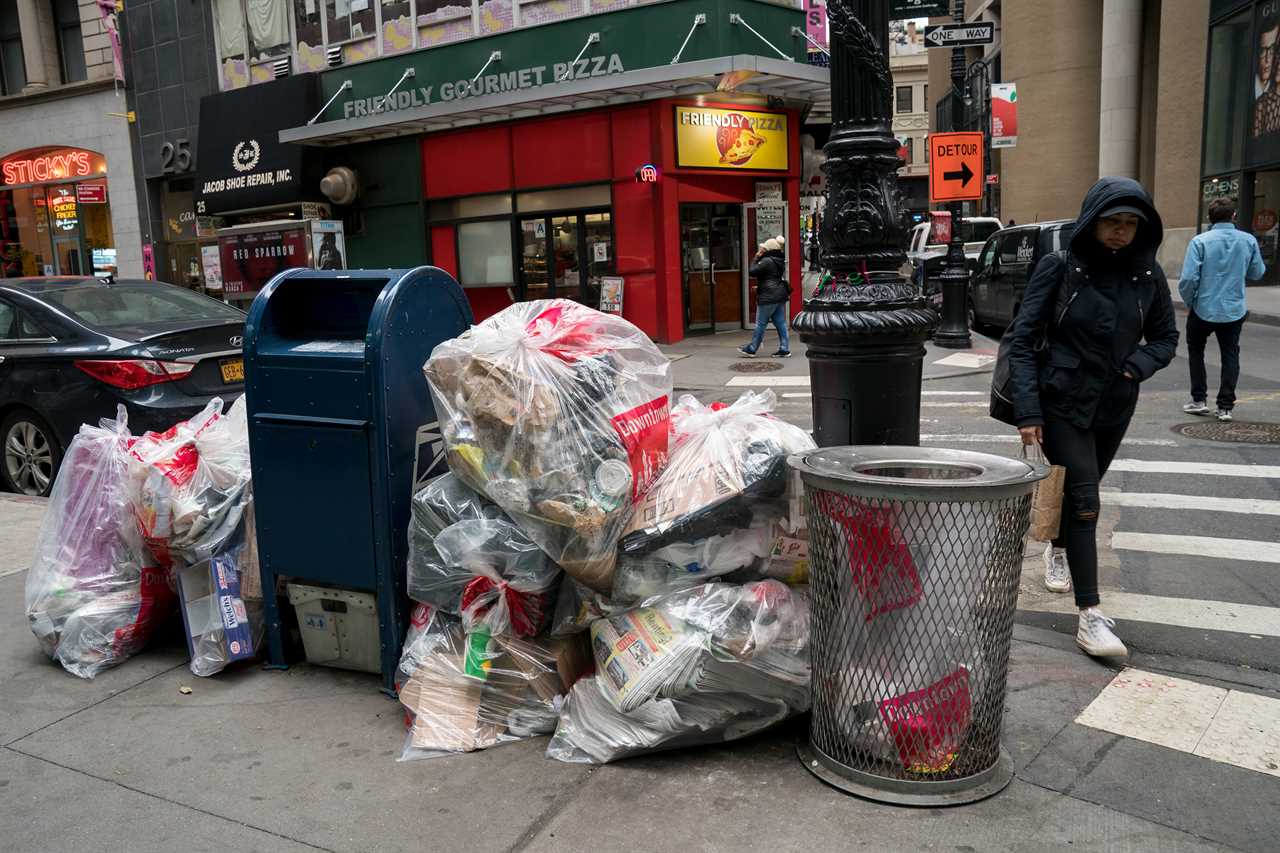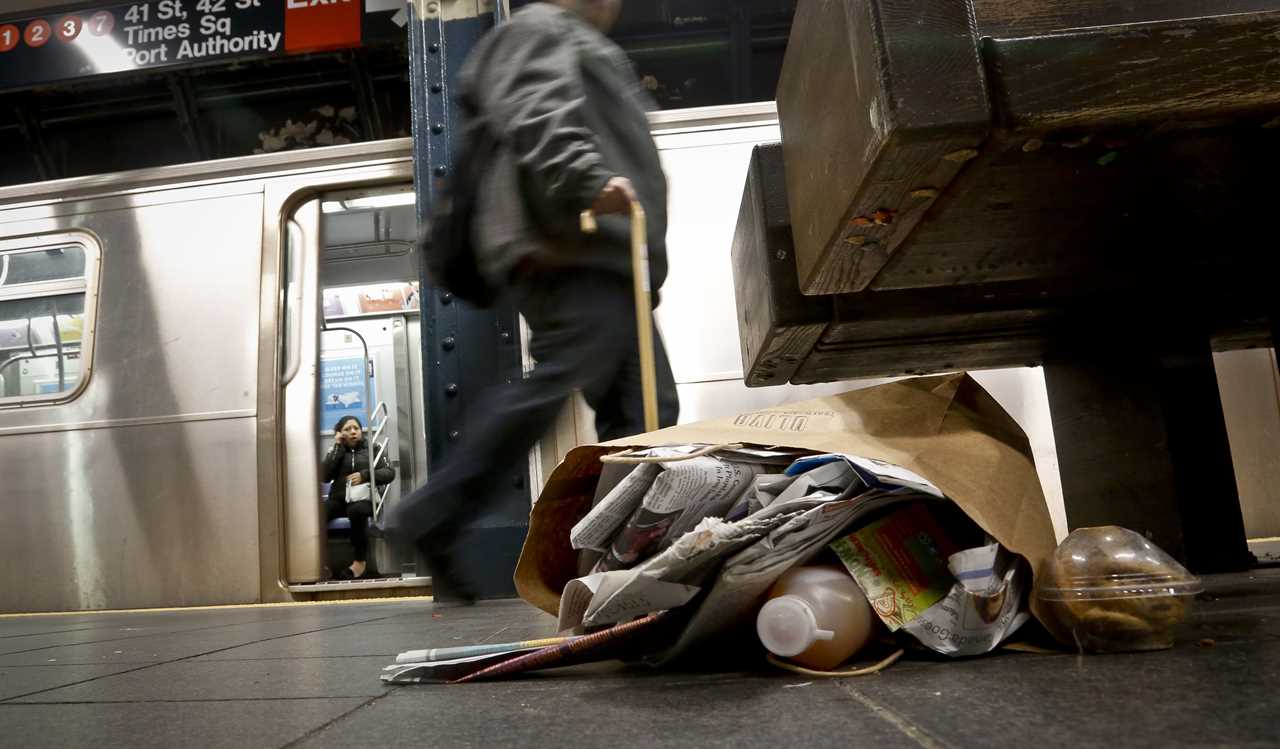
NEW YORK — Mountains of trash are getting steeper as the nation’s largest city inches away from its ambitious goal of nearly zeroing out residential waste by 2030, emblematic of the nation’s struggles with more garbage and limited recycling options.
City Hall cut street sweeping in half during the Covid-19 pandemic. Residents are recycling at their lowest level since 2015. Composting food scraps — which comprise one-third of household waste — is becoming harder as the program has been a target of budget cuts. And reforms to the private-sector industry that collects commercial waste have been delayed once again.
During his first “Earth Week” as mayor, Eric Adams is confronting a growing waste crisis he inherited with no end in sight. And how New York City, with its 8.4 million people, responds could either set the benchmark on how to effectively reduce waste or reflect a growing problem with few immediate remedies.
“We’re dealing with an economic crisis right now. And so we have to shift on how we make sure we look at those areas that we want to accomplish,” Adams said Wednesday at an unrelated press conference, when asked by POLITICO if the city could still achieve its zero waste goals. “It is possible. We’re going to fight to get there.”
The city’s runaway trash — which has only worsened since POLITICO’s extensive reporting on the matter in early 2020 — not only affects street cleanliness; it contributes to the global climate crisis. All refuse that isn’t recycled leaves the five boroughs, often in gas-belching trucks that haul it to landfills emitting methane — a greenhouse gas 25 times more potent than carbon dioxide.
Now Adams, who has emphasized beautifying city streets as he attempts to lure tourists and their wallets back to the city, is showing interest in the issue. He increased the budget for street sweeping this week by $11 million and launched a $1.3 million pilot program to get black trash bags off sidewalks and into tidy containers.
“To fully address climate change, we must significantly reduce New York City’s waste in an efficient and effective way,” mayoral spokesperson Kate Smart said in a prepared statement. “The mayor is committed to implementing innovative and creative solutions to reach our sustainability goals and secure a greener, more equitable future for all New Yorkers.”
A growing garbage issue in NYC

The mayor's steps, however, pale in comparison to the scale of the problem: At a cost of $452 million, New York shipped out nearly 3.4 million tons of household trash between July 1, 2020, and June 30, 2021, up from 3.2 million tons the prior year, according to the annual Mayor’s Management Report.
The increase represents a failure to realize former Mayor Bill de Blasio’s “zero waste” goal laid out in 2015.
At the same time, the residential recycling rate for metal, glass and plastic dropped to 17.6 percent in the fiscal year ending June 30, 2021, compared to 18.5 percent the year before. It further dipped to 16.5 percent during the period of July 1, 2021, through Oct. 31, 2021 — the lowest in seven years, according to the annual city report. In fact, New York repeatedly underperforms West Coast cities like Seattle, San Francisco and Los Angeles, whose leaders have implemented more stringent municipal trash conservation requirements over the past few decades that have yielded better recycling rates.
“Everything starts from the top with this mayor. It is very clear that he is governing this city as a very strong, heavy-handed executive and so he is going to have to set the tone,” City Council Member Sandy Nurse, chair of the sanitation committee, said in an interview. “If Mayor Adams wants zero waste to be a goal we are going to achieve, he is going to set the tone for that.”
Nurse added: “We really have the opportunity to showcase what a sustainable city can look like at the size of this city."
If New Yorkers met their recycling potential, more than two-thirds of household garbage would be diverted from landfills and incinerators, according to a 2017 Department of Sanitation analysis. But that achievement would require a citywide program for collecting food and yard waste, which has been subject to repeated budget cuts since it was launched by former Mayor Mike Bloomberg in 2013.
In fact City Hall — under de Blasio and now Adams — has not embraced the program environmentally-forward West Coast cities like Seattle and San Francisco mandated years ago.
Doubters in and out of city government have cited high costs and low participation.
Trying to make collections affordable

The city’s Independent Budget Office released a report last fall that concluded taxpayers spent $734 per ton to collect and process organic material in 2019, compared to $216 for regular trash and $206 for recycled materials.
The nonpartisan Citizens Budget Commission has repeatedly warned of the price tag, and last year suggested charging residents 50 cents for each 13-pound bag as a deterrent from tossing too much trash. The City Council has separately called for $1 million in the budget to explore financial incentives that could help divert waste from landfills.
“The mayor recognizes the success that these types of systems have had to drive increased recycling rates in other cities and is interested to understand what best practices from other cities might be feasible in New York City,” Smart responded.
De Blasio reduced the program at the outset of the pandemic, and the Department of Sanitation recently proposed cutting its planned expansion to comply with Adams’ mandated budget cuts for most city agencies. As it stands, only seven neighborhoods in the city offer curbside pickup. There are also 219 community bins that residents can leave food scraps in and close to 700 public schools participate in the city’s compost program.
Smart said Adams personally recycles and composts, and he plans to soon roll out a plan to address a program for the city.
The City Council — comprising 37 new lawmakers anxious to serve as a check on the executive branch — called for Adams to spend $27 million on various recycling initiatives left out of his preliminary budget proposal, putting trash management at the center of a political fight.
“This is an environmental justice issue; this is a racial justice issue; and just like the mayor’s favorite two words — this is a public safety issue,” Council Member Chi Ossé said at a rally last month.
In campaign literature, Adams called cuts to the city’s organics program a “mistake” and said he would look to the private sector to bring it back “citywide.” But he declined to take up the matter in this budget cycle.
The mayor defended his decision, calling the current system “broken” because of low participation. The city in 2017 collected roughly 1 percent of the 1 million tons of food and yard scraps tossed by New Yorkers annually. He said his team was looking at how to “get it right,” a sentiment his sanitation commissioner echoed at her first press conference.
“The best organics program is one that people use,” Sanitation Commissioner Jessica Tisch said. “So to create one that people use, we have to design one that’s both effective and cost effective.”
Building participation

Environmental advocates argue that low participation is because the program has faced repeated budget cuts and that it could save money in the long run by reducing the reliance on landfills and turning food scraps into useful products, like fresh soil or biogas.
“It’s hard to think of a more important priority than dealing with organics sustainably,” said Eric Goldstein, New York City environment director at the Natural Resources Defense Council. “Food waste, yard waste and food soil paper are the single largest portion of the residential waste stream.”
The City Council is calling for $18 million to resume the program and $3.5 million to set up more communal bins for food and yard waste. The Council also likely plans to introduce legislation that would mandate the city offer curbside composting to all households across the five boroughs, Nurse said.
Meanwhile, decades of neglect have led to poor recycling rates in the city’s public housing authority. The New York City Housing Authority recycles at a paltry rate of 1.5 percent, according to the most recent statistic available.
Representatives for the agency point to a series of measures intended to improve the situation: A first-of-its-kind initiative that collected more than 5,000 mattresses and box springs from 44 developments across the five boroughs, 80 percent of which was then recycled; a pilot program at seven complexes to compact cardboard; and easing the curbside pickup of organic material.
Last month, NYCHA began soliciting proposals from waste haulers and manufacturers of containerized collection equipment “to develop a pilot for bringing hoist-lifted trash to public housing developments.”
“This is envisioned as a way to containerize and remove refuse and recyclables from our properties, and to minimize unsightly bags of refuse and resulting rodent populations,” agency spokesperson Rochel Leah Goldblatt said. “NYCHA is reviewing responses with internal and external stakeholders to establish pilot locations” and plans to issue a formal request for proposals “later this year.”
The city’s collection system only covers homes and schools, leaving businesses and restaurants in the hands of a privately-regulated system long eyed for reform.
The private waste industry has long been documented for flouting recycling rules and has faced scrutiny for safety violations and dangerous driving.
The Adams administration is tasked with executing a law to better regulate the industry, by requiring companies to meet certain environmental and safety standards to win a contract to pick-up garbage. City Hall delayed its implementation, however, after private carters called for more time because of the pandemic, prompting outcry from more than a dozen Council members. The Council will soon hold an oversight hearing with city officials over where the regulatory effort stands.
Though Smart said Adams is “committed to achieving zero residential waste to landfills,” the city is hedging its bets.
“Just to be straightforward, zero waste by 2030 is a really hard thing to do,” Tisch said Monday. “I don’t want to say it’s achievable or not achievable, I want to dig in with the team and look hard at it and give you a really honest answer.”
Brooklyn Borough President Antonio Reynoso, who chaired the Council’s sanitation committee for two terms, marveled in a recent interview at the slow pace of progress on waste, from banning plastic grocery bags, to disincentivizing the production of plastic, to storing garbage in outside containers.
“Out of sight out of mind when it comes to trash,” he said. “It is a foundational piece to solving the climate change crisis. The amount of micro plastics and plastics in the sea, the amount of garbage we’re producing — it’s untenable. We have to get a hold of this, a handle on this and it needs to happen immediately.”
----------------------------------------
By: Sally Goldenberg and Danielle Muoio Dunn
Title: New York City fails zero waste pledge. Why it’s going backward.
Sourced From: www.politico.com/news/2022/04/22/zero-waste-new-yorkers-recycle-00026708
Published Date: Fri, 22 Apr 2022 06:13:06 EST






